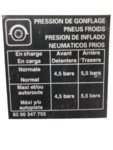Iain55
Full Member
- Messages
- 15
Hi all,
I am a newbie to motorhomes, got mine last August. I have not check my tyre pressures since I bought the vehicle.
They were all exactly 0.9 BAR below the sticker on the door.
I checked on the internet that seems correct for a Renault Master van.
However the sticker on the door says 4.5 and 5.5. My motorhome is 3.85 T (over 4 when fully laden)
In your experience does the door sticker seem correct ?

I am a newbie to motorhomes, got mine last August. I have not check my tyre pressures since I bought the vehicle.
They were all exactly 0.9 BAR below the sticker on the door.
I checked on the internet that seems correct for a Renault Master van.
However the sticker on the door says 4.5 and 5.5. My motorhome is 3.85 T (over 4 when fully laden)
In your experience does the door sticker seem correct ?

